Study of Two-Stage Economic Optimization Operation of Virtual Power Plants Considering Uncertainty
Abstract
1. Introduction
- (1)
- Optimized Economic Benefits: Significant enhancement of VPPs market revenue through the rational scheduling of EVs and ESS;
- (2)
- Improved System Stability: Reduction of power supply instability from uncoordinated EV charging and reliable operation through flexible energy storage dispatch;
- (3)
- Increased Market Participation: Lowering intra-day market penalty costs and boosting VPPs day-ahead bidding enthusiasm and flexibility, promoting efficient renewable energy utilization;
- (4)
- Promoted Energy Transition: Providing new theoretical and practical foundations for VPPs applications in the electricity spot market, advancing towards more sustainable and intelligent power systems.
2. The VPP Composition and Electricity Market Trading Framework
2.1. Composition of the VPP
2.2. WT Power Generation Units
2.3. PV System Power Generation Units
2.4. Gas Turbine Units
2.5. ESS
2.6. EVs Units
2.6.1. EVs Travel and Idle Periods
2.6.2. EVs’ Driving Distance
2.6.3. EV Battery Pack Charging and Discharging Model
2.7. The Bidding Rules and Process for VPPs Participating in Spot Market Trading
- (1)
- Prior to the conclusion of day D in the day-ahead electricity market trading, VPPs forecast the generation capacity of its internal distributed energy resources, internal load demands, and market electricity prices for day D + 1. Based on these forecasts, VPPs optimize the operation of its internal distributed resources with the goal of maximizing operational revenue. Subsequently, VPPs submit their bidding strategy for day D + 1 to the day-ahead electricity trading center (Independent System Operator, ISO). After the bidding process, the day-ahead electricity market operator announces the market clearing price and the awarded bid quantity for VPPs. VPPs then schedule the generation according to the awarded quantity on day D + 1 to ensure completion of the agreed-upon electricity transactions.
- (2)
- On day D + 1, VPPs control each distributed resource according to the day-ahead awarded bid quantity. Due to the difficulty in accurately predicting distributed WTs and PV system power outputs, there is often a deviation between the actual and planned outputs during operation. Consequently, there exists a discrepancy between the actual output of VPPs and the awarded bid quantity. If the actual output exceeds the awarded bid quantity, VPPs must sell the excess electricity in the intra-day market at a price lower than the market price. Conversely, if the actual operational output is lower than the awarded bid quantity, VPPs need to purchase additional electricity in the real-time balancing market at a price higher than the market price.
3. Scenario Analysis Method
3.1. Scenario Generation and Reduction for WTs and PV System Power Output
3.2. EVs Scenario Clustering
3.3. Scenario Generation and Reduction for Market Prices
4. Economic Optimization Decision Model for VPPs Based on Two-Stage Stochastic Programming
4.1. Two-Stage Optimization Strategy for VPPs
4.2. Objective Function
4.2.1. Day-Ahead Electricity Market Revenue
4.2.2. Revenue or Penalty Costs from Real-Time Electricity Market Transactions
4.2.3. Gas Turbine Fuel Costs
4.2.4. The Cost of Subsidies for EVs
4.2.5. Operating Cost of ESS
4.3. Constraints
4.3.1. Constraints on WTs and PV System Power Output
4.3.2. Constraints on ESS
4.3.3. Constraints on Gas Turbine Operation
4.3.4. Constraints on EVs
5. Case Analysis
5.1. Basic Data
5.2. Scenario Generation and Clustering Results
5.2.1. WTs and PV System Scenario Generation and Reduction
5.2.2. Clustering of Joint Electricity Price Scenarios
5.2.3. Clustering Scenarios for Electric Vehicles
5.3. Simulation Results Presentation and Analysis
5.3.1. First-Stage Day-Ahead Market Decision Results and Analysis
5.3.2. Second-Stage Intra-Day Market Decision Results and Analysis
5.3.3. Economic Benefit Analysis
6. Conclusions
Author Contributions
Funding
Data Availability Statement
Conflicts of Interest
References
- Liu, C.; Yang, R.; Wang, K.; Zhang, J. Community-Focused Renewable Energy Transition with Virtual Power Plant in an Australian City—A Case Study. Buildings 2023, 13, 844. [Google Scholar] [CrossRef]
- Cao, W.; Yu, J.; Xu, M. Optimization Scheduling of Virtual Power Plants Considering Source-Load Coordinated Operation and Wind–Solar Uncertainty. Processes 2024, 12, 11. [Google Scholar] [CrossRef]
- Ullah, Z.; Arshad; Hassanin, H. Modeling, Optimization, and Analysis of a Virtual Power Plant Demand Response Mechanism for the Internal Electricity Market Considering the Uncertainty of Renewable Energy Sources. Energies 2022, 15, 5296. [Google Scholar] [CrossRef]
- Cao, W.; Wang, S.; Xu, M. Optimal Scheduling of Virtual Power Plant Based on Latin Hypercube Sampling and Improved CLARA Clustering Algorithm. Processes 2022, 10, 2414. [Google Scholar] [CrossRef]
- Song, M.; Amelin, M. Purchase bidding strategy for a retailer with flexible demands in day-ahead electricity market. IEEE Trans. Power Syst. 2017, 32, 1839–1850. [Google Scholar] [CrossRef]
- Yi, Z.; Xu, Y.; Gu, W.; Wu, W. A Multi-time-scale Economic scheduling strategy for virtual power plant based on deferrable loads aggregation and disaggregation. IEEE Trans. Sustain. Energy 2020, 11, 1332–1346. [Google Scholar] [CrossRef]
- Vahedipour-Dahraie, M.; Rashidizade-Kermani, H.; Shafie-Khah, M.; Catalão, J.P. Risk-Averse Optimal Energy and Reserve Scheduling for Virtual Power Plants Incorporating Demand Response Programs. IEEE Trans. Smart Grid 2020, 12, 1405–1415. [Google Scholar] [CrossRef]
- Kardakos, E.G.; Simoglou, C.K.; Bakirtzis, A.G. Optimal Offering Strategy of a Virtual Power Plant: A Stochastic Bi-Level Approach. IEEE Trans. Smart Grid 2016, 7, 794–806. [Google Scholar] [CrossRef]
- Mei, S.; Tan, Q.; Liu, Y.; Trivedi, A.; Srinivasan, D. Optimal bidding strategy for virtual power plant participating in combined electricity and ancillary services market considering dynamic demand response price and integrated consumption satisfaction. Energy 2023, 284, 128592. [Google Scholar] [CrossRef]
- Wu, Q.; Li, C. A bi-level optimization framework for the power-side virtual power plant participating in day-ahead wholesale market as a price-maker considering uncertainty. Energy 2024, 304, 132050. [Google Scholar] [CrossRef]
- Tong, Y.; Meng, Z.; Qiu, P.; Cui, J.; Ma, J.; Tian, Y.; Wang, Z. The carbon trading operation optimization for virtual power plants of industrial parks considering wind power. J. Phys. Conf. Ser. 2023, 2474, 012032. [Google Scholar] [CrossRef]
- Zhang, L.; Zheng, H.; Cai, G.; Zhang, Z.; Wang, X.; Koh, L. Power-frequency oscillation suppression algorithm for ac microgrid with multiple virtual synchronous generators based on fuzzy inference system. IET Renew. Power Gener. 2022, 16, 1589–1601. [Google Scholar] [CrossRef]
- Islas, M.; Rubio, J.; Muñiz, S.; Ochoa, G.; Pacheco, J.; Meda-Campaña, J.; Mujica-Vargas, D.; Aguilar-Ibañez, C.; Gutierrez, G.J.; Zacarías, A. A fuzzy logic model for hourly electrical power demand modeling. Electronics 2021, 10, 448. [Google Scholar] [CrossRef]
- Abbasi, M.H.; Taki, M.; Rajabi, A.; Li, L.; Zhang, J. Coordinated operation of electric vehicle charging and wind power generation as a virtual power plant: A multi-stage risk constrained approach. Appl. Energy 2019, 239, 1294–1307. [Google Scholar] [CrossRef]
- Zhang, Y.; Liu, F.; Wang, Z.; Su, Y.; Wang, W.; Feng, S. Robust scheduling of virtual power plant under exogenous and endogenous uncertainties. IEEE Trans. Power Syst. 2022, 37, 1311–1325. [Google Scholar] [CrossRef]
- Ren, L.; Peng, D.; Wang, D.; Li, J.; Zhao, H. Multi-objective optimal dispatching of virtual power plants considering source-load uncertainty in v2g mode. Front. Energy Res. 2023, 10, 983743. [Google Scholar] [CrossRef]
- Fang, F.; Yu, S.; Xin, X. Data-driven-based stochastic robust optimization for a virtual power plant with multiple uncertainties. IEEE Trans. Power Syst. 2022, 37, 456–466. [Google Scholar] [CrossRef]
- Naughton, J.; Han, W.; Cantoni, M.; Mancarella, P. Co-optimizing virtual power plant services under uncertainty: A robust scheduling and receding horizon dispatch approach. IEEE Trans. Power Syst. 2021, 36, 3960–3972. [Google Scholar] [CrossRef]
- Tan, Z.; Tan, Q.; Wang, Y. Bidding strategy of virtual power plant with energy storage power station and photovoltaic and wind power. J. Eng. 2018, 2018, 6139086. [Google Scholar] [CrossRef]
- Dong, J. Decision-making model of virtual power plant for participating in spot market transaction based on hybrid stochastic and robust approach. Am. J. Environ. Resour. Econ. 2019, 4, 32. [Google Scholar] [CrossRef]
- Alahyari, A.; Pozo, D. Performance-based virtual power plant offering strategy incorporating hybrid uncertainty modeling and risk viewpoint. Electr. Power Syst. Res. 2022, 203, 107632. [Google Scholar] [CrossRef]
- Alahyari, A.; Ehsan, M.; Pozo, D.; Farrokhifar, M. Hybrid uncertainty-based offering strategy for virtual power plants. IET Renew. Power Gener. 2020, 14, 2359–2366. [Google Scholar] [CrossRef]
- Ji, W.; Wang, Y.; Deng, X.; Zhang, M.; Ye, T. Distributionally robust optimal dispatch of virtual power plant based on moment of renewable energy resource. Energy Eng. 2022, 119, 1967–1983. [Google Scholar] [CrossRef]
- Ju, L.; Tan, Z.; Yuan, J.; Tan, Q.; Li, H.; Dong, F. A bi-level stochastic scheduling optimization model for a virtual power plant connected to a wind–photovoltaic–energy storage system considering the uncertainty and demand response. Appl. Energy 2016, 171, 184–199. [Google Scholar] [CrossRef]
- Geng, S.; Tan, C.; Niu, D.; Guo, X. Optimal allocation model of virtual power plant capacity considering electric vehicles. Math. Probl. Eng. 2021, 2021, 5552323. [Google Scholar] [CrossRef]
- Sun, W.; Liu, S.; Dong, H.; Huang, Q. Electric power dispatching of virtual power plant with electric vehicle. J. Phys. Conf. Ser. 2022, 2409, 012019. [Google Scholar] [CrossRef]
- Baringo, A.; Baringo, L.; Arroyo, J. Day-ahead self-scheduling of a virtual power plant in energy and reserve electricity markets under uncertainty. IEEE Trans. Power Syst. 2019, 34, 1881–1894. [Google Scholar] [CrossRef]
- Zhong, W.; Chen, J.; Liu, M.; Murad, M.; Milano, F. Coordinated control of virtual power plants to improve power system short-term dynamics. Energies 2021, 14, 1182. [Google Scholar] [CrossRef]
- Yu, X.; Zhao, W. Participation of digital twin virtual power plants in power market trading model. Int. J. Manag. Stud. Soc. Sci. Res. 2023, 5, 131–135. [Google Scholar] [CrossRef]
- Shukla, A.; Verma, K.; Kumar, R. Impact of EV fast charging station on distribution system embedded with wind generation. J. Eng. 2019, 2019, 4692–4697. [Google Scholar] [CrossRef]
- Karaki, S.H.; Chedid, R.B.; Ramadan, R. Probabilistic performance assessment of autonomous solar-wind energy conversion systems. IEEE Trans. Energy Convers. 1999, 14, 766–772. [Google Scholar] [CrossRef]
- Li, Y.; Zhang, S.; Xiao, X.; Wang, Y. Charging and discharging scheduling strategy of EVs considering demands of supply side and demand side under V2G mode. Electr. Power Autom. Equip. 2021, 41, 129–135. [Google Scholar]
- Qian, K.; Liu, Y.; Zhang, X. Scenario-based probabilistic power flow calculation of distribution systems with electric vehicle charging loads. Power Syst. Prot. Control 2020, 48, 62–70. [Google Scholar]
- Dupacova, J.; Growekuska, N.; Romisch, W. Scenario reduction in stochastic programming: An approach using probability metrics. Math. Program. 2000, 95, 493–511. [Google Scholar] [CrossRef]
- Wang, R.; Wu, J.; Cai, Z.; Liu, G.; Zhang, H.; Cai, J. Optimal Dispatch of Virtual Power Plant Containing Electric Vehicles in a Multi-coordinated Market. South. Power Syst. Technol. 2021, 15, 45–55. [Google Scholar]
- Cai, X.; Cui, Y.; Dong, K.; Meng, Z.; Pan, Y.; Yu, Z.; Wang, J.; Meng, X.; Yu, Y. Day-ahead optimal scheduling approach of wind-storage joint system based on improved K-means and MADDPG algorithm. Energy Storage Sci. Technol. 2021, 10, 2200–2208. [Google Scholar]
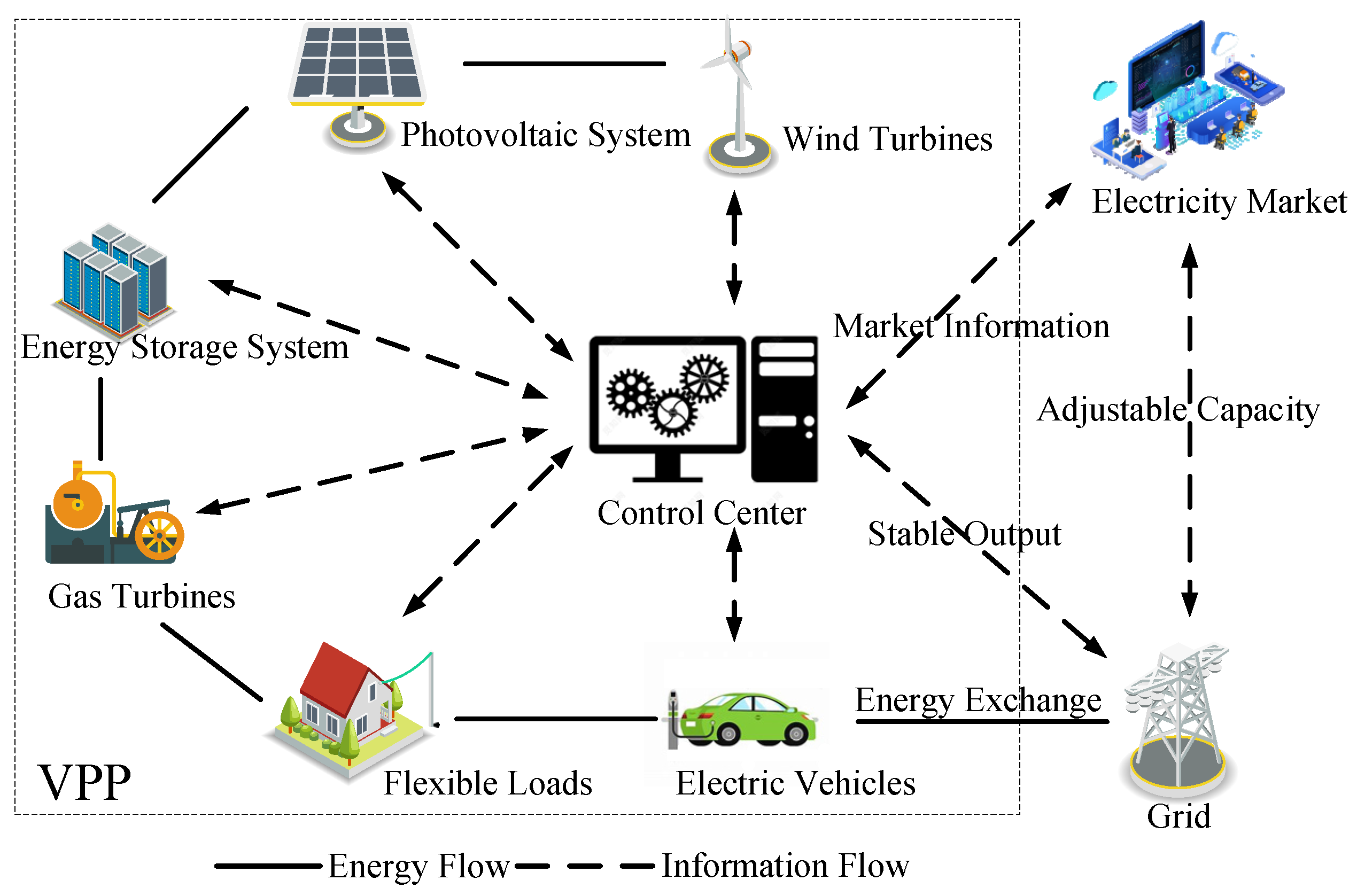

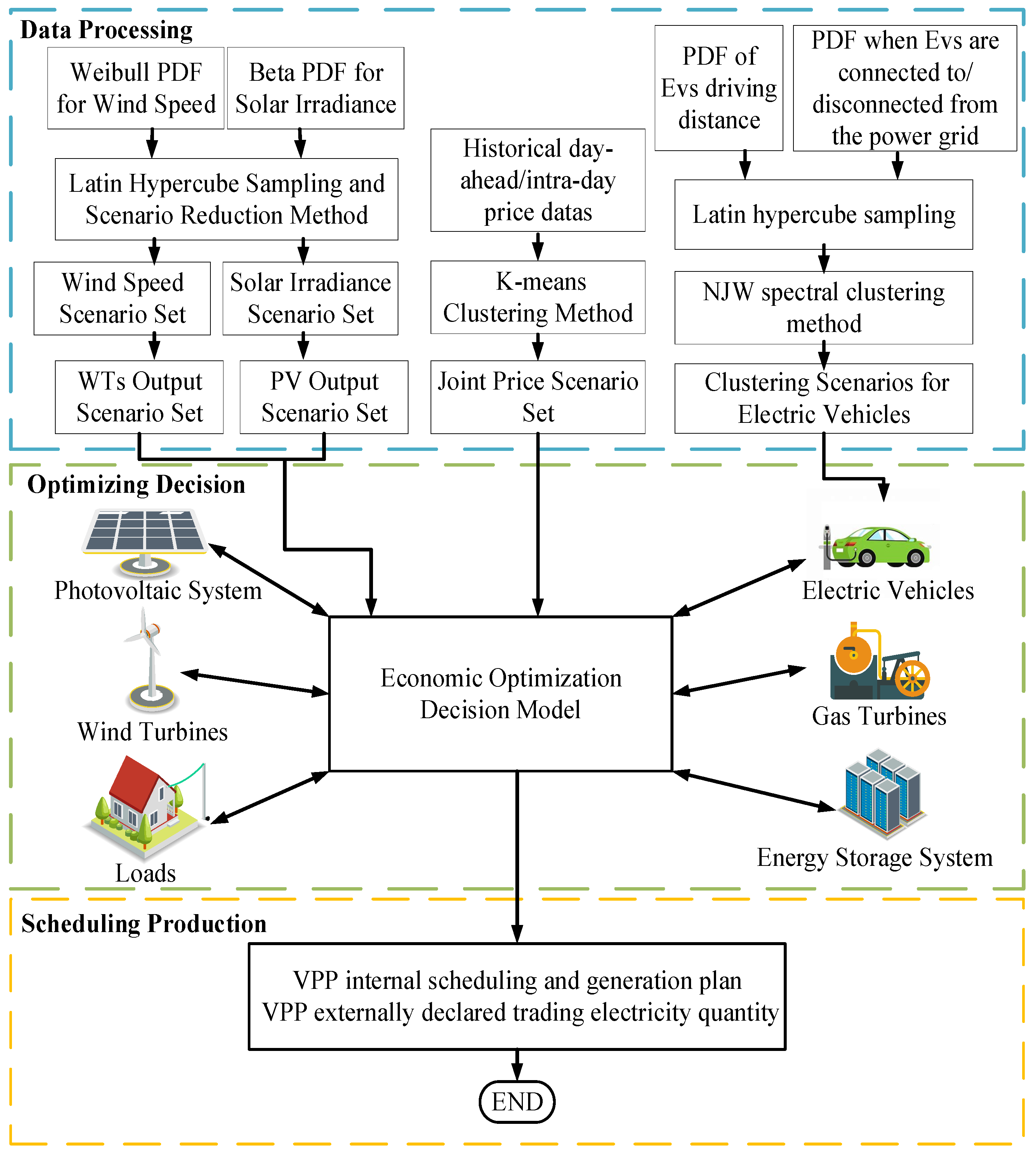


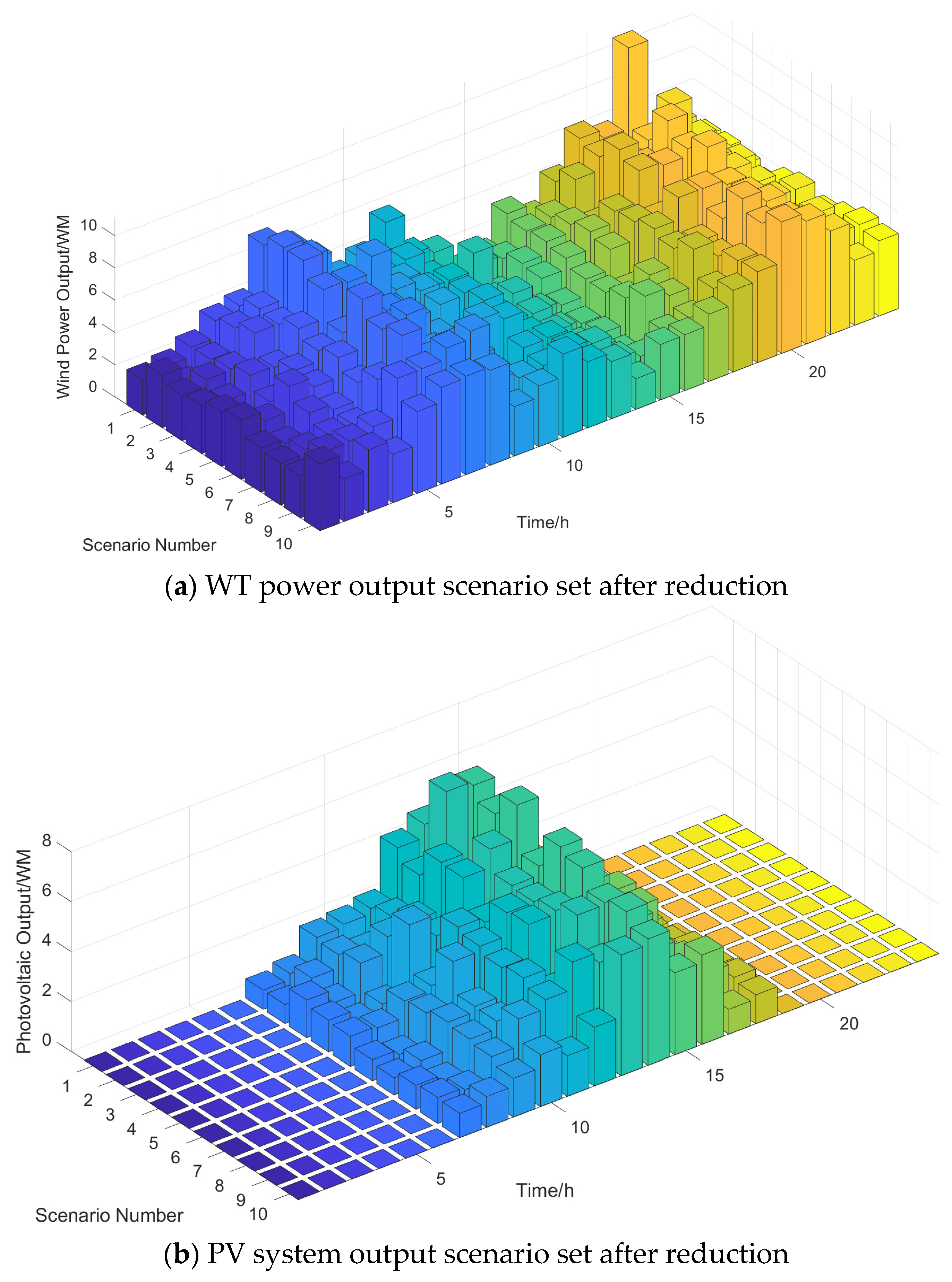
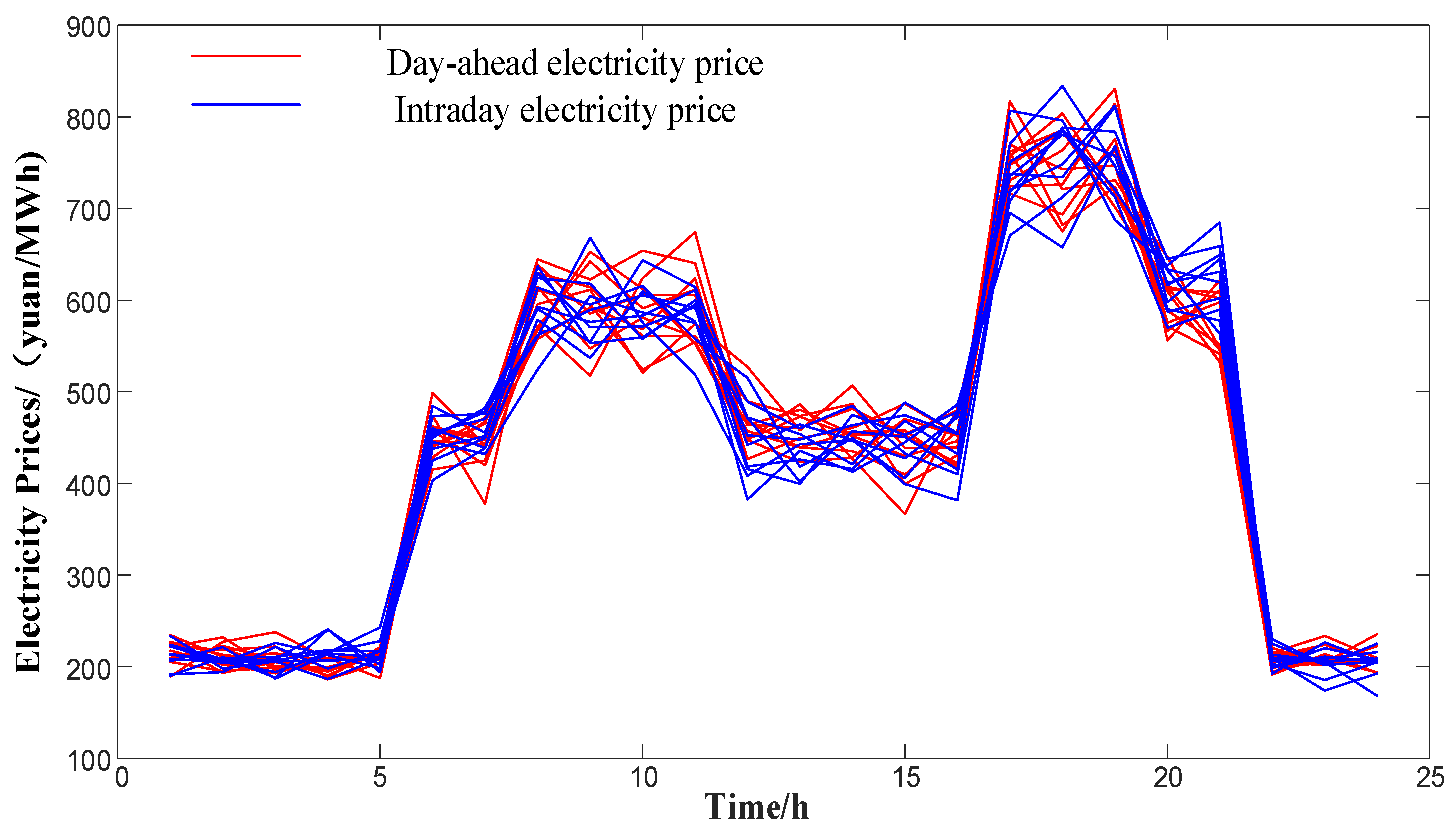

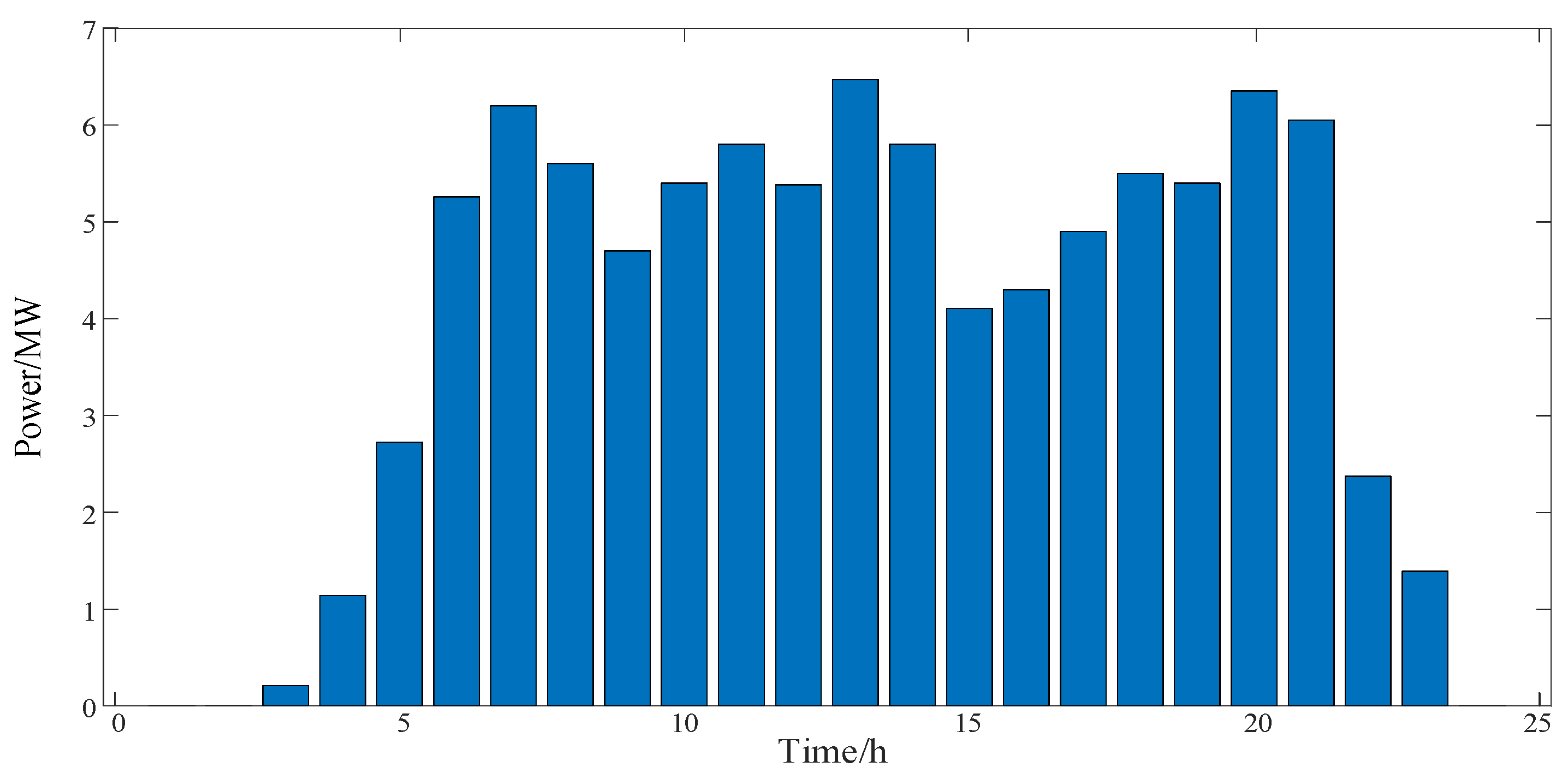

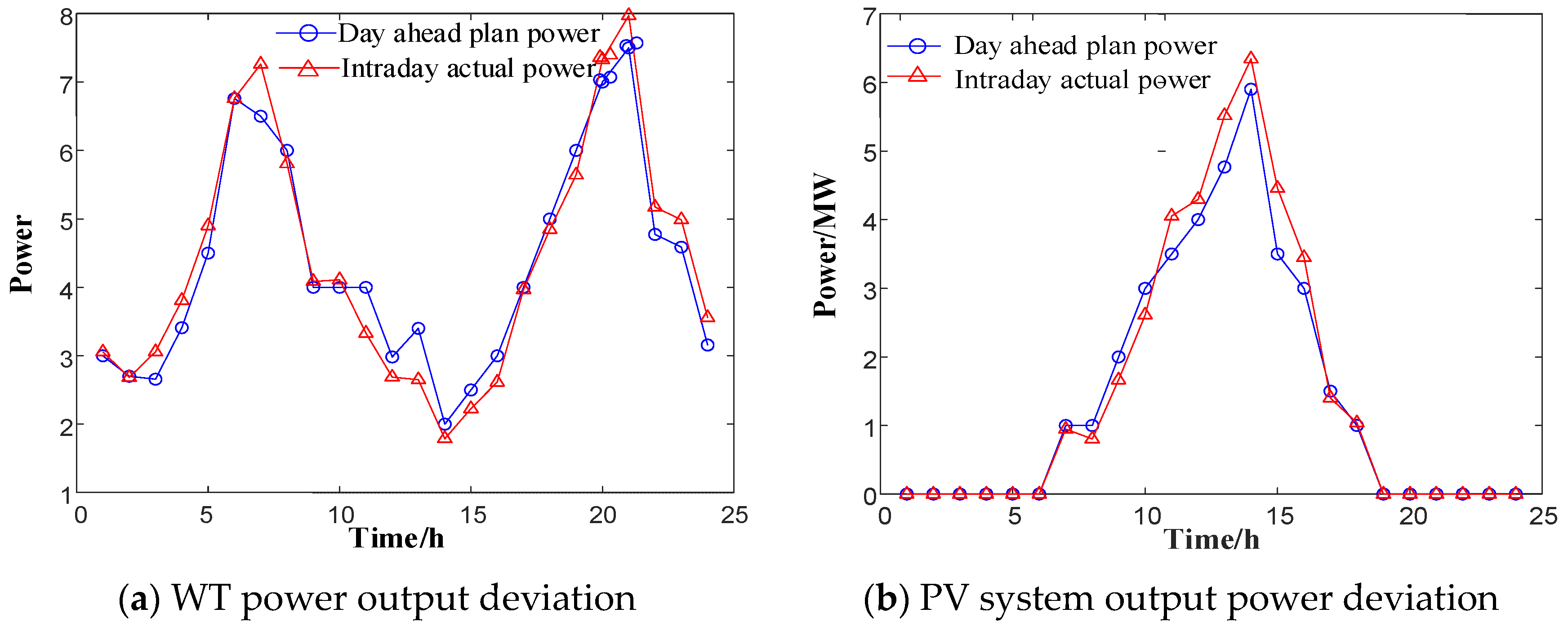
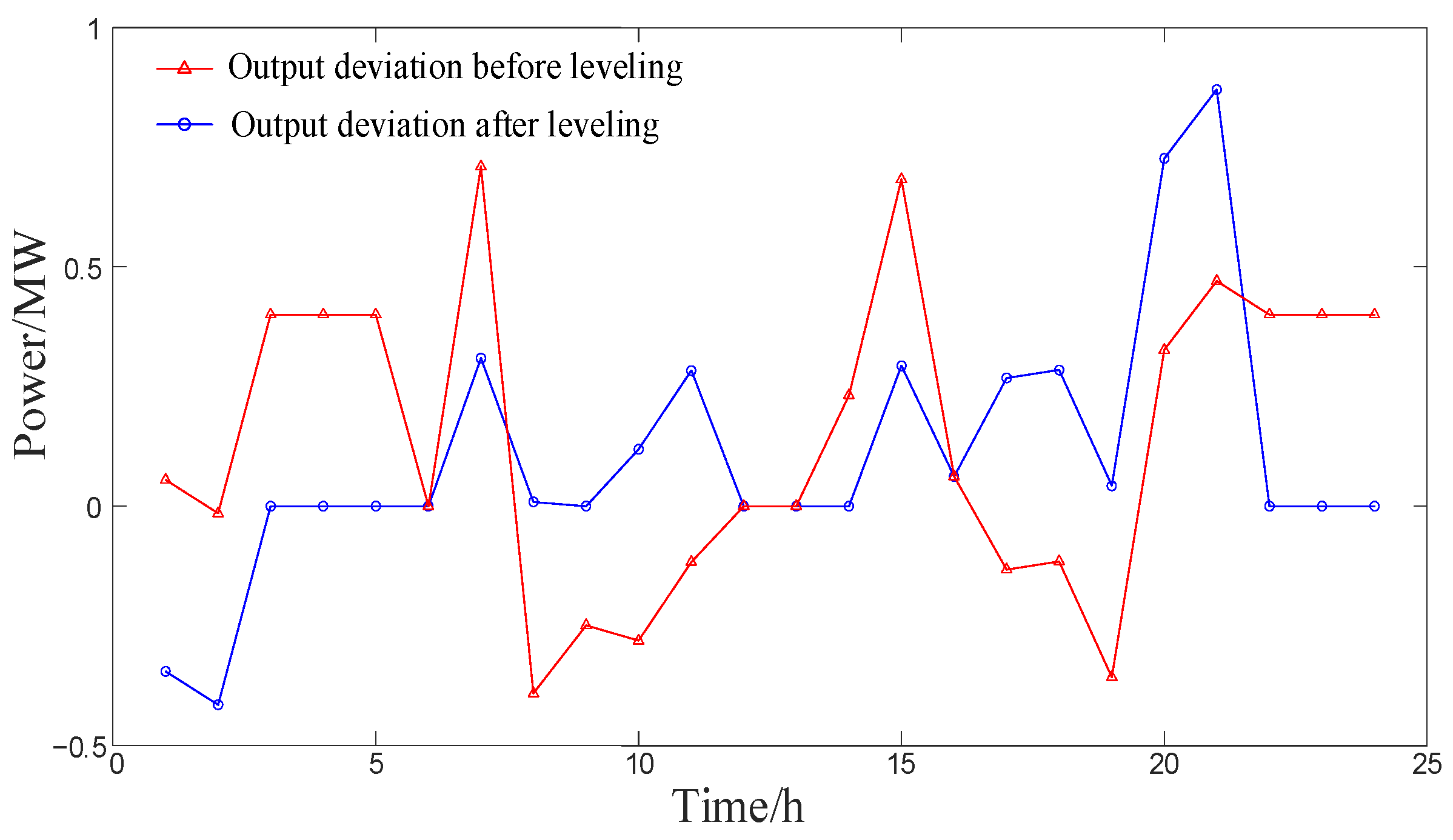
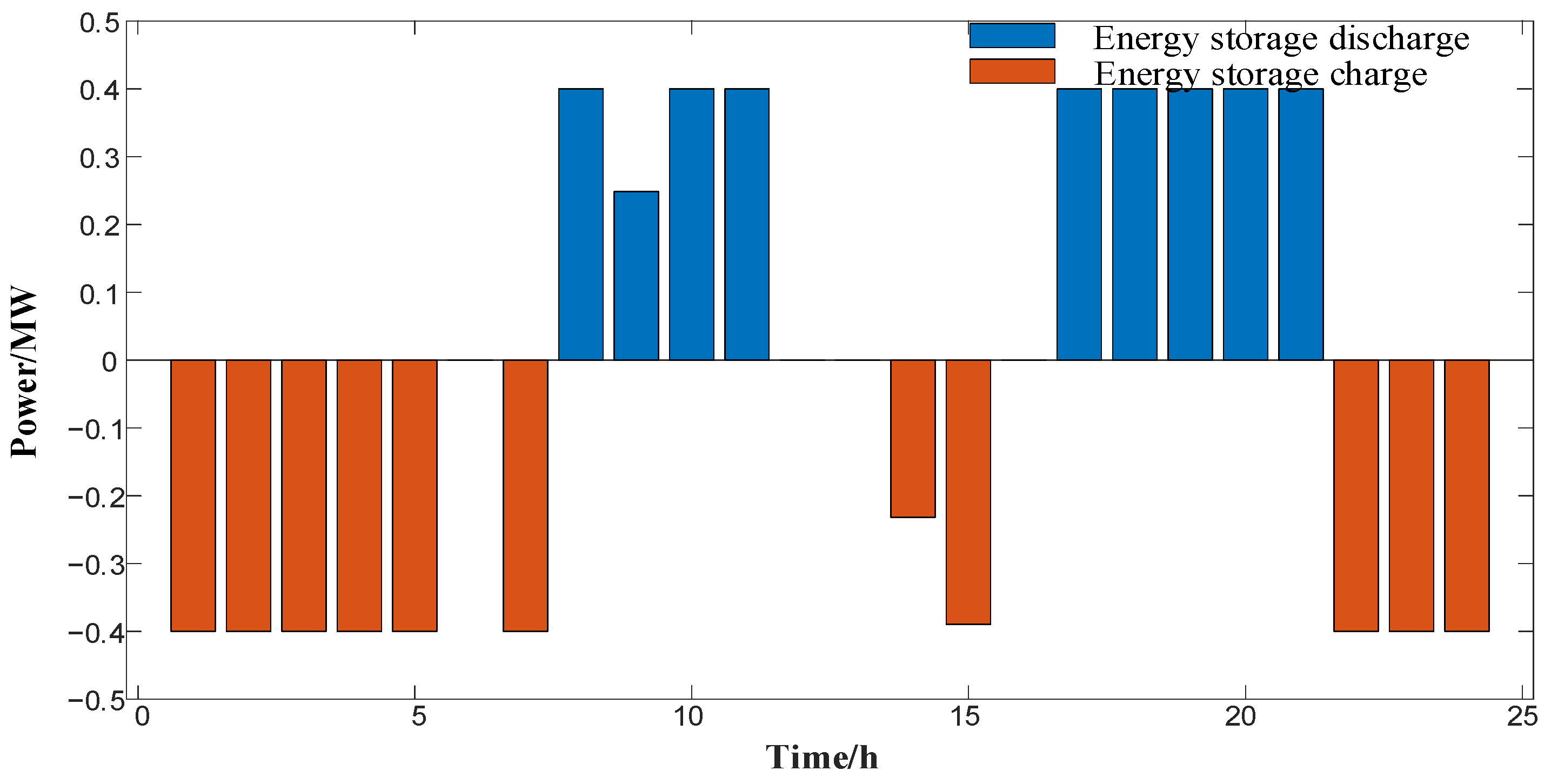
| Equipment | Parameter | Value |
|---|---|---|
| Gas turbine | Maximum/minimum power generation (MW) | 1.8 |
| Power generation efficiency | 0.7 | |
| Up and down climbing rate (MW/h) | 0.5 | |
| EVs | Battery capacity of a single EV (MWh) | 0.05 |
| Power consumption per kilometer (MWh) | 0.00015 | |
| Maximum and minimum State of Charge | 0.9, 0.1 | |
| Maximum charging/discharging power (WM) | 0.01 | |
| Minimum charging/discharging power (MW) | 0 | |
| ESS (composition of lithium batteries) | Rated capacity (MWh) | 4 |
| Maximum and minimum state of charge | 0.9, 0.1 | |
| Maximum charging power (MW) | 0.4 | |
| Minimum charging power (MW) | 0 |
| Parameter | Value (USD) |
|---|---|
| EV charging price (USD/MWh) | 55.1436 |
| EV discharge subsidy electricity price (USD/MWh) | 68.9295 |
| Operating cost of ESS charging and discharging (USD/MWh) | 6.88 |
| Natural gas (USD/m3) | 0.4136 |
| Penalty factor | 0.2 |
| Cluster | Off-Grid Time (Hours/Minutes) | On-Grid Time (Hours/Minutes) | On-Grid SOC Status |
|---|---|---|---|
| 1 | 3:52 | 14:46 | 0.714 |
| 2 | 5:55 | 16:26 | 0.645 |
| 3 | 7:34 | 17:35 | 0.626 |
| 4 | 9:12 | 20:24 | 0.668 |
| 5 | 11:13 | 21:41 | 0.639 |
| Scenario | Day-Ahead Market Revenue (USD) | EV Charging Revenue (USD) | Gas Turbine Fuel Cost (USD) | EV Discharging Subsidy Cost (USD) |
|---|---|---|---|---|
| one | 7022.7401 | 0 | 1470.9693 | 0 |
| two | 7268.573 | 437.559 | 1470.9693 | 337.9958 |
| three | 7435.6843 | 437.559 | 1470.9693 | 337.9958 |
| Scenario | Real-Time Balancing Market Revenue (USD) | ESS Operating Cost (USD) |
|---|---|---|
| one | 144.5396 | 0 |
| two | 144.5396 | 0 |
| three | 219.994 | 52.8689 |
| Scenario | Day-Ahead Market Total Revenue (USD) | Real-Time Balancing Market Total Revenue (USD) | Total VPP Revenue (USD) |
|---|---|---|---|
| one | 5551.7708 | 144.5396 | 5696.3104 |
| two | 5897.1669 | 144.5396 | 6041.7065 |
| three | 6064.2782 | 167.1251 | 6231.4033 |
Disclaimer/Publisher’s Note: The statements, opinions and data contained in all publications are solely those of the individual author(s) and contributor(s) and not of MDPI and/or the editor(s). MDPI and/or the editor(s) disclaim responsibility for any injury to people or property resulting from any ideas, methods, instructions or products referred to in the content. |
© 2024 by the authors. Licensee MDPI, Basel, Switzerland. This article is an open access article distributed under the terms and conditions of the Creative Commons Attribution (CC BY) license (https://creativecommons.org/licenses/by/4.0/).
Share and Cite
Sun, H.; Liu, Y.; Qi, P.; Zhu, Z.; Xing, Z.; Wu, W. Study of Two-Stage Economic Optimization Operation of Virtual Power Plants Considering Uncertainty. Energies 2024, 17, 3940. https://doi.org/10.3390/en17163940
Sun H, Liu Y, Qi P, Zhu Z, Xing Z, Wu W. Study of Two-Stage Economic Optimization Operation of Virtual Power Plants Considering Uncertainty. Energies. 2024; 17(16):3940. https://doi.org/10.3390/en17163940
Chicago/Turabian StyleSun, Hao, Yanmei Liu, Penglong Qi, Zhi Zhu, Zuoxia Xing, and Weining Wu. 2024. "Study of Two-Stage Economic Optimization Operation of Virtual Power Plants Considering Uncertainty" Energies 17, no. 16: 3940. https://doi.org/10.3390/en17163940
APA StyleSun, H., Liu, Y., Qi, P., Zhu, Z., Xing, Z., & Wu, W. (2024). Study of Two-Stage Economic Optimization Operation of Virtual Power Plants Considering Uncertainty. Energies, 17(16), 3940. https://doi.org/10.3390/en17163940






